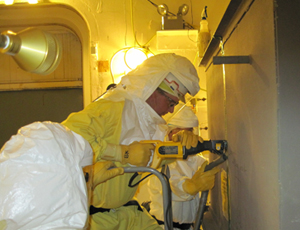

With radioactive contamination saturating the 209-East Critical Mass Laboratory at the U.S. Dept. of Energy’s Hanford Nuclear Waste Site in southeast Washington, contractor CH2M Hill Plateau Remediation Co. needed new techniques to demolish the nearly 9,000-sq-ft concrete research facility built in 1960.
After completing nearly two years of planning, Mike Swartz, deputy project manager for decommissioning and demolition at the firm, a unit of CH2M Hill Cos., Englewood, Colo., says the task's biggest challenge was removing its 11 slab tanks, each 4 ft tall by 20 ft long with 3-in.-thick concrete walls. Due to high levels of contamination in the tanks that once contained radioactive liquids, crews developed a first-ever “cutting shroud” while they were cut into five segments before being packaged for disposal at the Waste Isolation Pilot Plant in New Mexico.
The shroud fully enclosed the tanks, complete with a cutting saw and full HEPA filtration system, to create negative ventilation that fully encapsulated all contamination. Inside, two workers—in full nuclear safety gear—operated the saw and three more offered interior support.
Crews spent two months developing mockups, even fabricating non-contaminated replica tanks. “They chopped through the (replica) tanks and developed their technique and then went hot with it,” Swartz says. “It is the nature of our work to watch for contamination spread. It took a lot of planning.”
Removing the tanks was the demolition's toughest task, but not the only challenge for the project that wrapped up in December. “This is the most contaminated facility we have done to date,” Swartz says of the 118 buildings his team has demolished.
Crews also cut through 5-ft-thick concrete walls, removed 3-ft thick vault doors made of steel and reinforced concrete, dealt with asbestos-contaminated piping and removed “glove boxes” once used to handle plutonium before excavators demolished the remaining structure.
According to DOE, scientists used the 209-E facility to work with plutonium and uranium solutions. It features a mixing room with glove boxes and a mixing hood, and a control room from which experiments could be remotely monitored and controlled. The building also hosted research to test methods of protecting workers in the event of a nuclear accident.
No research or experiments have been conducted in the building since 1983.
“This is a nuclear facility that once required annual surveillance and maintenance, and it’s no longer here,” says J.D. Dowell, a DOE assistant manager. “This reduces the threat to the environment and the workforce as well as the annual costs for keeping Hanford safe.”
Twenty straight days of sub-freezing temperatures complicated a process that depended on fog-making machines to wet radioactive dust to keep it from spreading. “We were making snow,” Swartz says. “With all those hazards, ice fog and temperatures, we did it safely with no accidents. The excavators were all iced up and keeping everything running and lubed was a challenge, but we lost no time.”
“We want to take the lessons learned from this project and translate it to our work at the PFP [Plutonium Finishing Plant],” says Swartz. The 62-year-old complex of 60 buildings once housed the final stage of plutonium production at Hanford, during which the material in liquid form was processed into various solid forms for use in weapons production nationwide.
The PFP has vaults and “thick, hardened walls” that will make decontamination and eventual demolition tough. Removal work has begun, with full demolition to "slab on grade" expected by 2016, he says.


Post a comment to this article
Report Abusive Comment